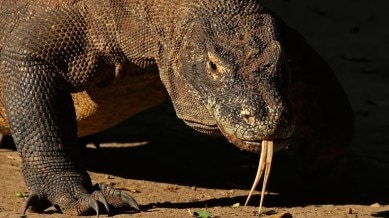📣 For more lifestyle news, click here to join our WhatsApp Channel and also follow us on Instagram
Meet the lizard, found in India, that can grow up to 9 feet
From the Komodo dragon’s brute strength to the crocodile monitor’s agility, the world’s biggest lizards are as fascinating as they are formidable.

Lizards come in all shapes and sizes, from tiny geckos to massive, prehistoric-looking beasts. Some of the most enormous lizards on Earth are apex predators in their ecosystems, while others are gentle giants.
These massive reptiles help maintain healthy populations of prey animals, control pests, and even disperse seeds through their diet. Unfortunately, habitat destruction, poaching, and climate change threaten many species. Conservation efforts are essential to protect these incredible giants of the reptile world.
monthly limit of free stories.
with an Express account.
Let’s explore the world’s largest lizards and what makes them so fascinating.
1. Komodo Dragon (Varanus komodoensis) – The King of Lizards
Size: Up to 10 feet (3 meters) long and weighing over 150 pounds (70 kg)
Habitat: Indonesia (Komodo, Rinca, Flores, and nearby islands)
The Komodo dragon is the undisputed largest lizard in the world. These prehistoric-looking predators are armed with razor-sharp teeth, venomous saliva, and immense strength. They can take down large prey like deer and even buffalo, relying on their powerful bite to weaken victims before feasting. Despite their fearsome reputation, they are highly intelligent and even display social behaviors.
2. Perentie (Varanus giganteus) – Australia’s Giant Monitor
Size: Up to 8 feet (2.5 meters) long
Habitat: Australian deserts and scrublands
The Perentie is Australia’s largest lizard and one of the fastest. This elusive predator can sprint at high speeds, using its agility and strength to hunt rabbits, birds, and reptiles. Perenties have forked tongues, which they use to detect scents like snakes. Despite their intimidating size, they avoid humans and are rarely seen in the wild.
3. Crocodile Monitor (Varanus salvadorii) – The Longest Lizard
Size: Up to 10 feet (3 meters) long (but lighter than Komodo dragons)
Habitat: Papua New Guinea
With its exceptionally long tail, the crocodile monitor is often considered the longest lizard in the world. These tree-dwelling giants have sharp claws and powerful jaws, making them excellent climbers and hunters. They are brilliant, sometimes compared to Komodo dragons in terms of learning ability. Despite their fearsome look, they are shy and rarely aggressive toward humans.
4. Asian Water Monitor (Varanus salvator) – The Aquatic Giant
Size: Up to 9 feet (2.7 meters) long and over 100 pounds (45 kg)
Habitat: Southeast Asia (Thailand, Indonesia, India, Sri Lanka, etc.)
One of the most adaptable and widespread large lizards, the Asian water monitor is often found near rivers, lakes, and even urban areas. These strong swimmers use their muscular tails to glide through water while hunting fish, birds, rodents, and carrion. They are surprisingly fast on land, reaching speeds that allow them to escape predators.
5. Lace Monitor (Varanus varius) – The Australian Tree Climber
Size: Up to 7 feet (2.1 meters) long
Habitat: Eastern Australia
The lace monitor is a powerful climber, often found scaling trees in search of eggs, birds, and small mammals. With striking black and yellow patterns, they are among the most beautiful large lizards. Despite their size, lace monitors can be timid around humans, though they will defend themselves with sharp claws and a strong tail whip if threatened.
📣 For more lifestyle news, click here to join our WhatsApp Channel and also follow us on Instagram